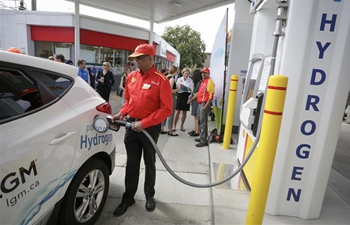HOUSTON, June 16 (Xinhua) -- The number of active drilling rigs in the United States fell by three this week to 1,059, but still 126 more than this time last year, according to weekly data collected by Baker Hughes released Friday.
The Houston-based oilfield services company Baker Hughes reported that oil drillers added one rig, but that was offset by a decline of four natural gas rigs. Now the number of active drilling rigs in the United States reaches 863, the highest level since March 2015.
The Permian Basin region of West Texas and New Mexico dominates drilling activity with 476 rigs, accounting for more than half the oil drilling rigs in the country.
Meanwhile, Canada gained 27 oil rigs for the week after gaining 13 oil and gas rigs last week, but still 20 less than this time last year.
According to the forecast by U.S. Energy Information Administration (EIA) on Friday, global petroleum and other liquids inventories will increase by 210,000 barrels per day next year, a factor that, all else being equal, typically puts downward pressure on oil prices. It also expected Brent crude oil prices will average 71 U.S. dollars per barrel this year and 68 dollars per barrel in 2019.
Crude oil prices have reached high levels as global oil inventories have generally declined from January 2017 through April 2018.
On Friday, oil prices settled sharply lower on Friday as traders believed that the Organization of the Petroleum Exporting Countries (OPEC) and its allies will agree next week to boost output.
The West Texas Intermediate (WTI) for July delivery dropped 1.83 U.S. dollars to settle at 65.06 dollars a barrel on the New York Mercantile Exchange, while Brent crude for August delivery lost 2.50 dollars to 73.44 dollars a barrel on the London ICE Futures Exchange.
In the week ending June 8, U.S. commercial crude oil inventories, excluding those in the Strategic Petroleum Reserve, decreased by 4.1 million barrels after buildup of 2.1 million barrels in the previous week.
U.S. crude oil refinery inputs averaged about 17.5 million barrels per day during the week ending June 8, which was 136,000 barrels per day more than the previous week's average.
At 432.4 million barrels, U.S. crude oil inventories are in the lower half of the average range for this time of year.
Total products supplied over the last four-week period averaged more than 20.4 million barrels per day, up by 1.7 percent from the same period last year.
Over the past four weeks, motor gasoline product supplied averaged about 9.6 million barrels per day, up by 0.3 percent from the same period last year.
Distillate fuel product supplied averaged 4.0 million barrels per day over the past four weeks, down by 0.5 percent from the same period last year. Jet fuel product supplied was up 1.2 percent compared with the same four-week period last year.













